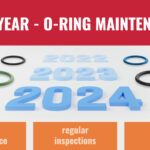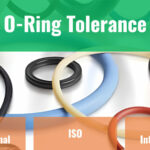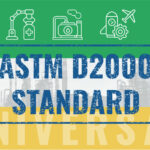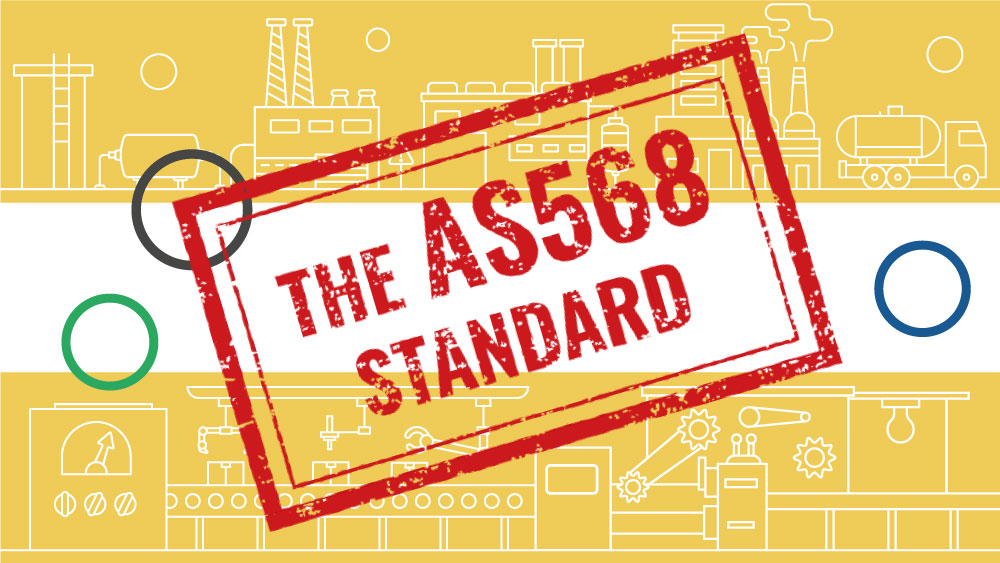
Summary
- The AS568 standard is a systematic set of guidelines for o-rings, defining 394 sizes and establishing universal dimensions to ensure interchangeability and functionality across industries.
- Understanding the AS568 standard is critical for both manufacturers and end-users. It ensures compatibility, reduces the risk of failures, improves safety, and boosts overall reliability.
- The AS568 standard offers numerous benefits, such as streamlined sourcing, optimized costs, simplified inventory management, and enhanced quality, resulting in higher customer satisfaction and reduced maintenance costs.
Introduction
In a world where industrial machinery and systems become more intricate daily, the need for precision and compatibility has never been more critical. One component that plays a surprisingly integral role in the efficient operation of countless machinery and devices is the o-ring. This small component acts as a simple and effective seal, preventing the escape of gases or fluids from machinery and ensuring optimal operation.
At the heart of o-ring design and use is a comprehensive set of guidelines known as the AS568 standard. This standard, widely accepted by manufacturers and engineers worldwide, is far more than a mere list of sizes. It is the cornerstone of o-ring functionality, ensuring compatibility, quality, and interchangeability. In this blog post, we will delve deep into the intricacies of the AS568 standard, shedding light on its definition, significance, benefits, and application. As we traverse this path, we will underscore the importance of such standards in preserving the efficiency and reliability of our industrial landscape.
A Dive into History: The Genesis of the AS568 Standard
- The Early Days: Before the industrial revolution, seals were rudimentary and often inconsistent as each manufacturer employed their own sizes. A failed seal meant a challenging search for an exact replacement, leading to delays and increased costs.
- The Need for Standardization: The urgent requirement for uniformity in the industry led to the inception of the AS568 standard. Initiated by the Society of Automotive Engineers (SAE), the goal was to develop a standard o-ring size system that industries could universally adopt.
- The Development Process: The SAE developers had the daunting task of compiling data from different manufacturers, understanding various applications, and creating an easy-to-understand system.
- The Outcome: In 1958, the SAE officially published the AS568 standard, which initially included 379 sizes. As the industry evolved, the standard incorporated more dimensions and refined certain technical aspects.
- The Effect: The AS568 standard revolutionized the sealing industry and has become a global phenomenon. It created a uniform system to refer to, making design, manufacturing, and procurement more straightforward and efficient.
Defining the AS568 Standard
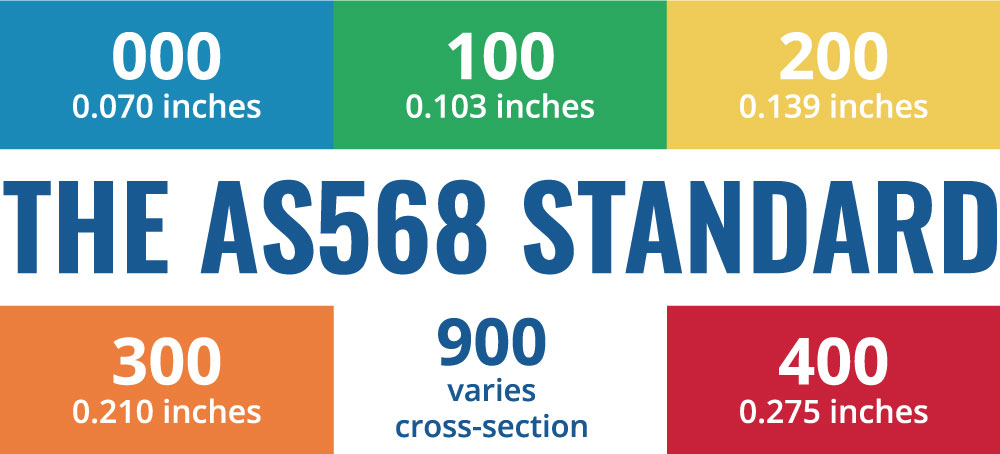
The AS568 standard is a systematic set of guidelines for o-rings across the industry. It’s a catalog that includes 394 different sizes. This size range ensures a fit for virtually any application. The AS568 is not just a reference chart – it’s an integral part of the design process, playing a vital role in quality control, manufacturing, and procurement.
Understanding the dimensions of an o-ring is key to its proper function. Each AS568 number corresponds to a specific set of measurements: the inner diameter (ID) and the cross-sectional diameter (CS). By creating a universal standard for these dimensions, the AS568 ensures that o-rings made by different manufacturers will be interchangeable, fitting into the same grooves and sealing against the same surfaces.
A unique aspect of the AS568 standard is its classification into different series, each corresponding to a specific cross-section or, equivalently, the thickness of the ring. The AS568 includes five series – 000, 100, 200, 300, and 400 – each corresponding to a different standard cross-section, 0.070 inches (1.78 mm), 0.103 inches (2.62 mm), 0.139 inches (3.53 mm), 0.210 inches (5.33 mm), and 0.275 inches (approximately 6.99 mm), respectively. There is one additional series, the 900 series, where the cross-section varies.
Tolerance is a critical aspect of the AS568 standard that requires consideration. Tolerance refers to the allowable variation in the dimensions of a manufactured part. Even with the most precise manufacturing processes, slight variations are inevitable. Tolerances define an acceptable range for these variations, ensuring that the piece performs its intended function even if its dimensions are not exactly specified. In the case of o-rings, tolerances are important to guarantee a proper seal, despite minor variations in groove dimensions, hardware deformations, and changes in temperature or pressure.
At Global O-Ring and Seal, our AS568 chart specifies the inside diameter, cross-sections, tolerances, and AS568 size identification codes (dash numbers). To interact with the chart, simply search for any one of the dimensions and find the standard size that fits your needs. The dash number is also linked to our online store, where you can see the wide range of products we offer in the size you need and our availability.
Significance of the AS568 Standard
Comprehending the AS568 standard is indispensable, not just for manufacturers but also for end users. By ensuring compatibility between o-rings and their matching hardware, the AS568 standard reduces the risk of product failures, enhancing safety and boosting reliability.
For manufacturers, the AS568 standard is an invaluable tool for designing and building machinery. It provides a common language, helping designers, engineers, and manufacturers across the globe to effectively communicate their requirements, regardless of their location or the specific application.
The standard helps simplify and expedite replacing worn or damaged o-rings in the maintenance and repair sector. By referring to the AS568 standard, technicians can quickly identify the size of the o-ring they need, confident that a replacement of the same size will provide an appropriate fit.
Benefits of Employing AS568 Standard Sizes
The benefits of utilizing AS568 standard sizes extend beyond compatibility. The first and most significant advantage is the ease and speed of sourcing. With a standardized reference, manufacturers and repair technicians can quickly locate and purchase the required o-rings, regardless of the original manufacturer, which can reduce downtime during equipment failure and simplify the procurement process for new machinery.
Another advantage is that the standard optimizes costs and streamlines inventory management. Manufacturers can reduce costs associated with maintaining a wide range of custom sizes and instead focus on stocking a selection of common standard sizes across various applications. For companies that service and repair machinery, this means they can maintain a smaller inventory, knowing that the sizes they have on hand will be suitable for a wide range of equipment.
Furthermore, using AS568 standard sizes helps to ensure quality and consistency. With all manufacturers adhering to the same standard, there is less risk of variations between batches or brands, leading to better performance and longer service life, ultimately resulting in higher customer satisfaction and lower maintenance and replacement costs.
Exploring Applications: The Reach of the AS568 Standard
The AS568 standard is not limited to a specific industry. Instead, it boasts wide-ranging applicability across multiple sectors owing to the diversity of o-ring sizes and compounds it encompasses. This standard’s influence is omnipresent, aiding in the efficient functioning of various systems, from everyday appliances to complex industrial machinery.
- Automotive Industry: The standard ensures reliability and safety in fuel, cooling, and transmission seals.
- Aerospace and Aviation Industries: It provides high-quality components for engines and hydraulic systems.
- Oil and Gas Industry: The AS568 standard guarantees durability in extreme conditions.
- Pharmaceutical and Food Processing Industries: The standard allows for effective, safe sealing in contact with consumable products.
- General Industrial Machinery: The AS568 standard prevents leakage and enhances operational efficiency.
This wide-ranging application of the AS568 standard is a testament to its universal acceptance and effectiveness. With its precise specifications, the standard ensures reliable and consistent performance across an extensive array of industries and applications, making it an indispensable tool in manufacturing and engineering. To read more on how various industries benefit from o-rings and seals, click here.
The Future of the AS568 Standard: A Look at Possible Trends

As the global manufacturing industry continues to evolve and innovate, it’s crucial to anticipate potential changes in the AS568 standard. Let’s explore a few possible future trends that could shape the landscape of o-ring standards in the coming years.
1. Inclusion of More Sizes
The AS568 standard has previously expanded from its initial 379 sizes to 394. As technologies evolve, requiring different specifications and components, the standard will likely include even more sizes to cater to the needs of increasingly specialized and miniaturized machinery.
2. More Rigorous Tolerance Controls
As manufacturing processes become more advanced, the precision and quality of o-rings may continue to increase. The AS568 standard may introduce tighter tolerance controls to reflect this increased precision, ensuring the o-ring’s superior fit and performance.
3. Digitalization and 3D Modelling
The advent of Industry 4.0 and digital manufacturing processes, such as 3D printing, could reshape the AS568 standard. The standard might integrate digital specifications and 3D modeling into its framework, enabling rapid prototyping, customization, and production of o-rings and further streamlining the manufacturing and replacement process.
4. Enhanced Quality Assurance Processes
As quality assurance processes become more comprehensive, the AS568 standard may reflect these improvements. For example, more robust and detailed testing requirements could be incorporated into the standard, providing an even stronger o-ring performance and durability guarantee.
The AS568 standard has proven adaptable by responding to industry changes over the past six decades. As we move forward into a future marked by rapid technological advancements, this standard will likely continue evolving to meet the ever-changing needs of the manufacturing industry. As your reliable o-ring supplier, we remain committed to staying at the forefront of these changes, ensuring our o-rings are always up to the latest standard.
Conclusion: Embracing the AS568 Standard
Understanding and utilizing the AS568 standard for o-rings is fundamental to various industries’ effective and efficient operation. This standard provides a consistent, reliable framework that ensures compatibility, simplifies inventory management, reduces costs, and optimizes operational efficiency. It plays an integral role in different sectors, from automotive to aerospace, oil and gas, and food processing.
In the evolving industrial manufacturing and engineering world, keeping pace with such standards is vital. It helps maintain the quality and integrity of your operations and provides a competitive edge in the marketplace.
As a trusted distributor of o-rings and related seals, Global O-Ring is dedicated to supporting our client’s needs, offering an extensive range of products that adhere to the AS568 standard. Feel free to visit our website for a full AS568 Size Table or to shop our AS568-sized o-rings. Have a specific o-ring in mind? You can filter our online store by AS568 size, material, color, and durometer. If you don’t know the AS568 size, try searching by dimensions. If an AS568 size is a match, it will show in the results. Trust us to deliver high-quality o-rings for all your sealing requirements.

 English
English  Español
Español  Français
Français  Português
Português  Deutsch
Deutsch  Italiano
Italiano  Русский
Русский  中文
中文  日本語
日本語  العربية
العربية  हिन्दी
हिन्दी 